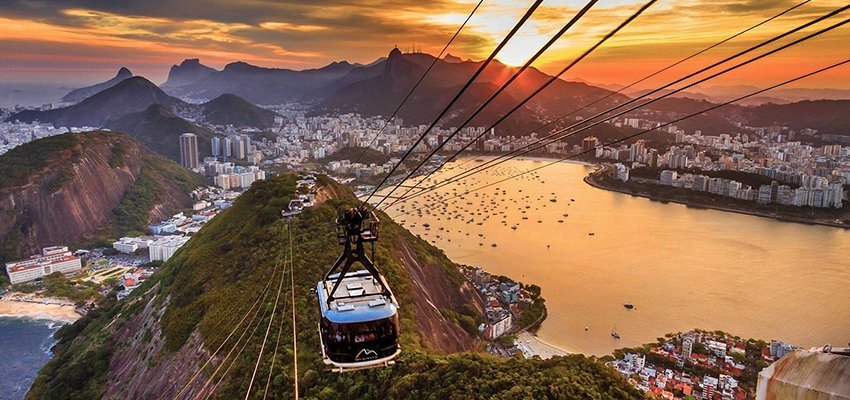
Rising dramatically from the Atlantic Ocean at the mouth of Guanabara Bay, Sugarloaf Mountain (Pão de Açúcar) is one of Brazil’s most iconic natural landmarks and a must-see destination for anyone visiting Rio de Janeiro. With its rounded granite peak soaring 396 meters (1,299 feet) above sea level, it has become a symbol of Rio’s natural beauty, cultural allure, and adventurous spirit.
The most exhilarating and scenic way to reach the summit of Sugarloaf is via the world-famous cable car ride, known locally as the “Bondinho do Pão de Açúcar.” From the moment you step into the glass-walled gondola, you are treated to panoramic vistas that stretch across Rio’s skyline, its sprawling beaches, lush tropical forests, and the shimmering waters of the Atlantic. Whether you’re an avid photographer, a thrill-seeker, or a romantic soul, the journey to Sugarloaf’s summit offers an unforgettable sensory experience that captures the heart and soul of Brazil.
A Journey Through the Skies: The Cable Car Experience
The Sugarloaf cable car system consists of two legs:
- First Leg: Praia Vermelha to Morro da Urca
Your journey begins at the Praia Vermelha (Red Beach) station in the charming neighborhood of Urca. As the cable car slowly ascends, you gain a bird’s-eye view of the tranquil bay below, rimmed with boats and speckled with colorful houses. The ride lasts just a few minutes, but the scenes are so dramatic that they stay etched in your memory forever. - Second Leg: Morro da Urca to Sugarloaf Mountain
After a short stop at Morro da Urca, where visitors can explore restaurants, souvenir shops, and scenic lookouts, the next cable car whisks you even higher to the summit of Sugarloaf. This second leg of the journey is the true highlight, offering a 360-degree panorama that reveals the full grandeur of Rio de Janeiro. From this vantage point, you can see the famous Copacabana Beach, the forested hills of Tijuca National Park, the Christ the Redeemer statue perched on Corcovado Mountain, and the Niterói Bridge stretching across the bay.
The entire ascent takes less than 10 minutes, but the experience is timeless.
A View That Defines a City
Once at the top of Sugarloaf, you’ll find yourself standing on a wide, landscaped platform with numerous lookout points, seating areas, and even a small bar where you can sip on a caipirinha as you watch the world go by. The view is arguably the most comprehensive and cinematic of all Rio vistas — even more so than the view from Corcovado.
- To the South, you’ll see the endless curves of Copacabana and Ipanema beaches, their golden sands kissed by gentle surf and lined with iconic sidewalks.
- To the West, the Christ the Redeemer statue watches over the city with open arms, its spiritual presence adding depth to the natural beauty.
- To the North, the bustling downtown of Centro contrasts with the tranquil greenery of the city’s many parks.
- To the East, across the waters, lies Niterói, another city connected to Rio by the massive bridge spanning Guanabara Bay.
Whether you visit at sunrise, midday, or sunset, each hour brings new light and a different mood, offering photographers and dreamers alike the perfect setting to pause, reflect, and marvel.
History of the Cable Car: Brazil’s First
The Sugarloaf cable car holds the distinction of being the first cable car system in Brazil and the third in the world when it opened in 1912. Originally built using wooden cabins and basic steel cables, it has since undergone multiple modernizations to meet international safety and comfort standards.
Today, the gondolas are sleek, glass-paneled vessels capable of carrying up to 65 passengers per trip. They glide smoothly and silently along high-tension cables, ensuring a safe yet thrilling ride even for those wary of heights.
Interestingly, this cable car ride has a legacy in pop culture as well — it was famously featured in the 1979 James Bond film “Moonraker,” where Roger Moore battles villains mid-air atop the cable car!
Morro da Urca: More Than a Transfer Point
Though often seen as just a transit stop on the way to Sugarloaf, Morro da Urca, at 220 meters high, is a destination in its own right. The area features:
- Observation decks with stunning views
- Restaurants and snack bars
- A helipad, where visitors can book aerial tours over the city
- Open-air concerts and events, especially during weekends
- Walking trails, including the famous Cláudio Coutinho Trail, which winds through lush Atlantic forest at the mountain’s base
Morro da Urca is also where many visitors pause for a break, enjoying local cuisine, drinks, or just the feeling of floating above one of the world’s most picturesque cities.
Romance, Adventure, and Celebration
Sugarloaf Mountain is more than just a viewpoint — it’s a setting that has hosted marriage proposals, wedding photoshoots, meditation retreats, yoga classes, and adrenaline-pumping rock climbs.
- Sunset cable car rides are especially popular among couples.
- Wedding and event venues on Morro da Urca provide unforgettable backdrops.
- For the adventurous, the granite cliffs of Sugarloaf are ideal for rock climbing, with routes ranging from beginner to expert levels.
- The New Year’s Eve fireworks seen from Sugarloaf are said to rival those of Copacabana Beach.
Every visitor brings a story, and Sugarloaf offers a stage that makes those stories larger than life.
Nature Meets Metropolis
One of the most striking features of the Sugarloaf experience is the way it balances urban dynamism with pristine natural beauty. The mountain itself is part of a protected conservation area and is home to:
- Monkeys
- Toucans
- Hawks
- Colorful butterflies
- Native Atlantic forest vegetation
Walking the trails or simply pausing on the observation decks lets you connect with Rio’s rich biodiversity, even while surrounded by a sprawling metropolis.
Planning Your Visit
Getting There
The base station is located in the neighborhood of Urca, easily accessible by taxi, ride-share, or public transportation. Many travelers walk from nearby Botafogo or Flamengo for a scenic approach.
Ticket Information
Cable car tickets can be purchased online or at the ticket booth. Prices vary for adults, children, and seniors. Booking in advance is recommended, especially during high season (December–March) or holidays.
Opening Hours
The Sugarloaf cable car typically operates from 8:00 AM to 9:00 PM, with the last ascent occurring around 8:00 PM. Visiting during off-peak hours ensures fewer crowds and better photo opportunities.
What to Bring
- Comfortable shoes for walking and light hiking
- A camera or smartphone with plenty of storage
- A light jacket, especially if visiting around sunset
- Sunscreen and sunglasses
- Local currency or a card for snacks and souvenirs
Nearby Attractions
After your descent from Sugarloaf, consider exploring nearby attractions:
- Praia Vermelha: A quiet beach perfect for relaxation or kayaking
- Fortaleza de São João: A historic military fort with scenic views
- Museu de Ciências da Terra: A natural history museum just a short walk away
- Cláudio Coutinho Trail: A flat, shaded trail ideal for walking or jogging
These sites make the entire Urca area worth exploring for a full day of nature, history, and leisure.
Why Sugarloaf is a Bucket List Destination
Sugarloaf Mountain is not just a beautiful place — it’s a symbol of Brazilian identity and pride. It’s been the subject of paintings, poems, music, and dreams for over a century. Its silhouette against Rio’s skyline is instantly recognizable around the globe, and riding the cable car to its summit is one of the defining experiences of any trip to South America.
From honeymooners to solo travelers, adventure seekers to families, Sugarloaf offers a versatile, enriching, and awe-inspiring journey. The harmony of sea, sky, forest, and stone come together in one breathtaking panorama — and the feeling of floating toward it in a glass capsule is nothing short of magical.
Conclusion: A Skyward Adventure That Stays with You
Riding the cable car to the top of Sugarloaf Mountain is not just an activity — it’s a pilgrimage into the soul of Rio de Janeiro. It’s a chance to rise above the noise, to see the bigger picture, and to be swept away by the sheer beauty of a city that pulses with life.
As you descend from the mountain, with the ocean breeze on your skin and images of the skyline in your heart, you carry with you more than just photographs — you carry a piece of Rio, etched in memory and framed by the vast Brazilian sky.




